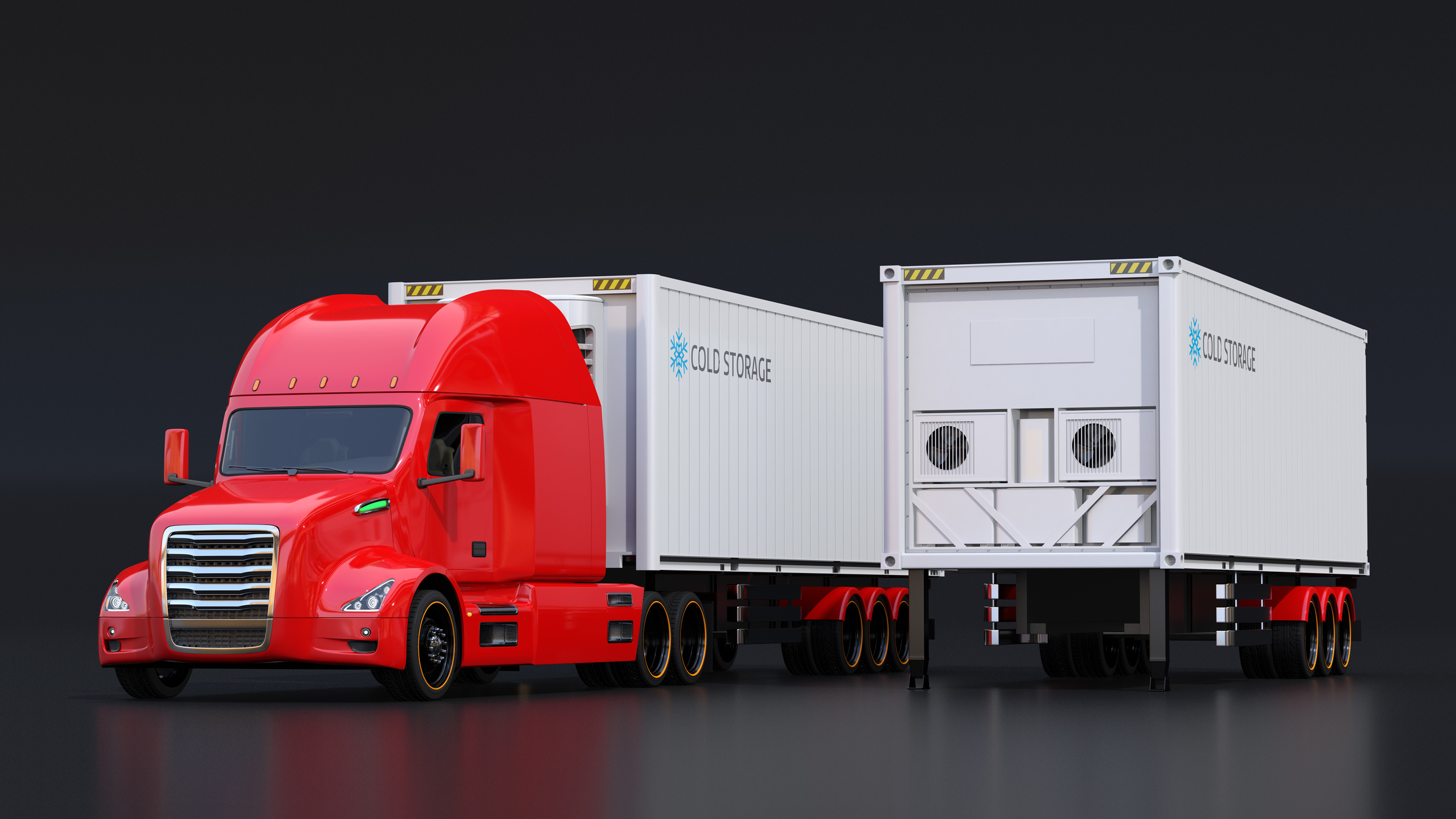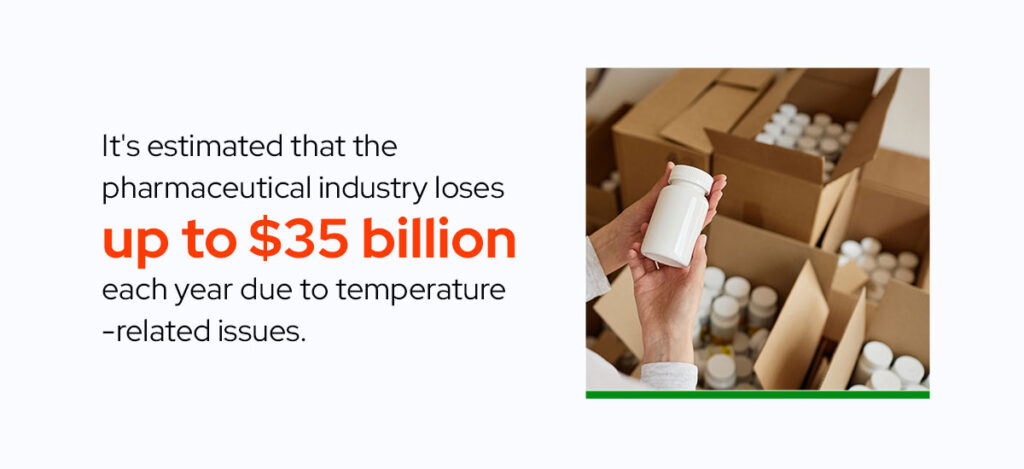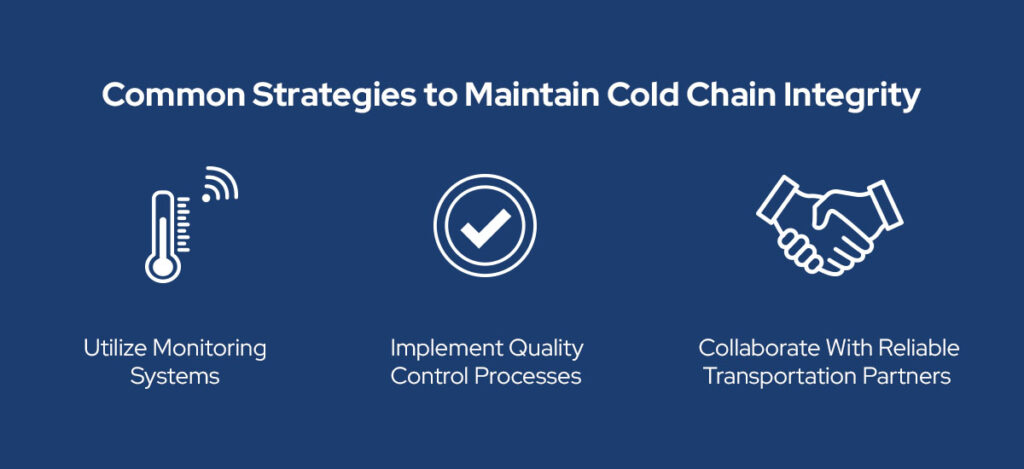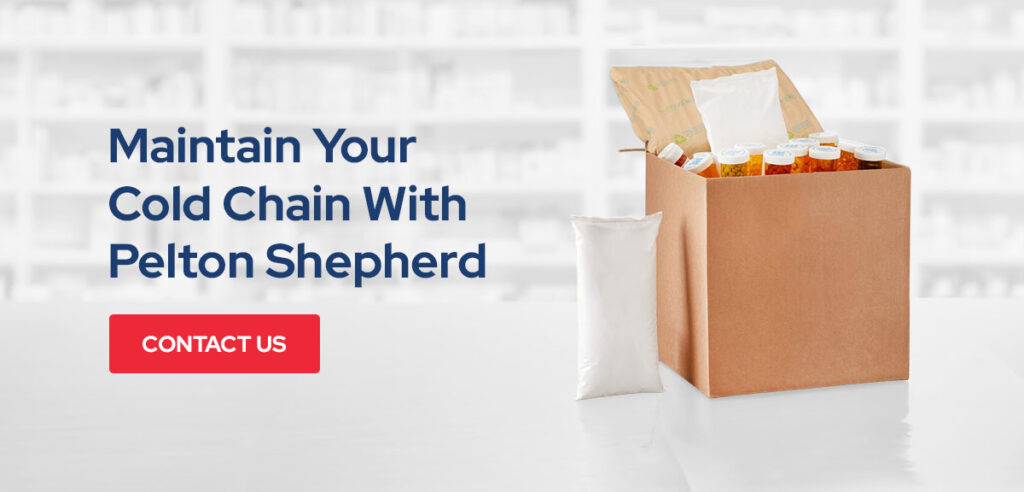
Cold chain shipping is the end-to-end process of transporting temperature-sensitive products and maintaining precise temperature control. With expanding e-commerce markets and a growing demand for direct-to-consumer refrigerated products, cold chain shipping is thriving. Researchers expect the global cold chain market to be worth over $410 billion by 2028.
Despite it being a booming industry, maintaining the cold chain while keeping shipping costs low and adhering to regulations is a challenge. Every stage of the cold chain, from packaging through the last mile, requires careful planning to ensure product quality, safety and efficacy.
In this guide, we’ll explore the challenges involved in shipping perishables and cover general best practices to overcome these challenges.
Importance of Cold Chain Shipping for Controlled Products
Cold chain shipping ensures the integrity of temperature-sensitive products such as foods, beverages and pharmaceuticals. These products require specific temperature conditions throughout the supply chain.
For example, according to the Centers for Disease Control and Prevention, vaccines should be stored at temperatures between 36 F and 46 F. Anything below or above that temperature range could compromise vaccine potency and render an entire shipment unusable.
Without proper temperature control, any perishable product can spoil, lose potency or even pose health risks to consumers. Cold chain shipping is therefore essential for preserving the quality and safety of temperature-sensitive products during transportation.
Overview of Temperature Control in Cold Chain Shipping
Temperature-controlled shipping involves knowing a product’s optimal temperature range and creating the conditions to maintain that specific temperature range throughout transport.
It generally requires insulated packaging and refrigerants to preserve the freshness of food and beverages, prevent bacteria growth, and ensure the efficacy and safety of pharmaceuticals. Monitoring devices and safe handling practices are also needed to maintain temperature control at every step of the cold chain.
Key Factors: Cold Chain Integrity and Compliance
Cold chain integrity refers to the uninterrupted preservation of the controlled temperature environment throughout the shipping process. It involves maintaining the desired temperature range, preventing temperature excursions and minimizing exposure to external factors that could compromise product quality.
Compliance with regulations and industry standards is equally important to ensure that cold chain shipments meet requirements. Adhering to these standards helps businesses mitigate risks, avoid costly penalties and maintain the trust of customers and regulatory authorities. Both cold chain integrity and compliance are essential to successful cold chain shipping.
Challenges in Shipping Temperature-Sensitive Products
Shipping temperature-sensitive products poses one of the most complex logistical challenges. Every step between the raw material supplier and consumer must be coordinated to maintain the cold chain.
Throughout this process, many internal or external issues can arise that could lead to a temperature excursion, from unexpected traffic delays to equipment failure. Cold chain shippers must therefore be prepared to handle challenges such as the following:
Preventing Temperature Fluctuations

Perishable products are highly sensitive to temperature fluctuations. Even slight deviations from the recommended temperature range can have detrimental effects on their quality and safety and lead to product loss. For example, it’s estimated that the pharmaceutical industry loses up to $35 billion each year due to temperature-related issues.
External factors such as ambient temperature and weather conditions can present significant challenges and will impact decisions on how to ship temperature-sensitive items. Businesses must implement robust temperature monitoring systems and employ appropriate measures to mitigate these challenges and ensure that the perishable products remain within the required temperature range.
Ensuring Adequate Packaging and Insulation
Proper packaging and insulation are vital in protecting controlled products during transit. Packaging solutions should provide adequate insulation to minimize heat transfer and reliable refrigerants to protect against temperature variations. Solutions like insulated shipping boxes and durable gel packs can help maintain the desired temperature throughout the shipping process.
Following Proper Handling Procedures
Implementing strict handling procedures helps prevent temperature fluctuations and ensures that the integrity of the controlled products is preserved throughout the shipping journey. Staff involved in the handling and transporting of perishable products should receive proper training on temperature-sensitive items and the importance of maintaining the cold chain.
Training should include minimizing exposure to ambient temperatures, using appropriate handling equipment and following established protocols for loading and unloading.
Minimizing Shipping Costs
Shipping cold chain products comes with large expenses. Maintaining precise temperature control can require significant energy in the form of refrigerated trucks or electric cooling systems. Additionally, poorly planned routes can quickly increase fuel costs, especially during times of peak demand and higher prices.
Shippers can reduce cold chain shipping costs by using affordable refrigerant solutions and consolidating shipments. They can also work with a cold chain logistics partner to optimize their process.
Adopting Sustainable Shipping Practices
Government efforts, like the Paris Agreement, and consumer preferences for sustainable brands have placed increasing pressure on businesses to decrease their carbon footprint. Since cold chain shippers must prioritize temperature control, finding ways to be more eco-friendly is a unique challenge.
Innovative solutions like sustainable gel packs enable cold chain businesses to divert waste from landfills and spread positive brand messages to their customers.
Maintaining Cold Chain Integrity
With its many challenges, cold chain shipping requires careful, innovative thinking to ensure temperature excursions do not happen. Here are some of the strategies commonly used in cold chain management to keep products safe:

Utilize Monitoring Systems
Monitoring systems continuously track and record temperature data at various points along the supply chain, providing real-time insights into the condition of the controlled products. They allow businesses to identify temperature excursions or deviations from the desired range promptly.
Monitoring systems provide visibility and enable proactive measures to maintain the cold chain, mitigating the risk of compromised product quality.
Implement Quality Control Processes
Quality control processes include implementing standard operating procedures (SOPs) that outline specific guidelines for handling, storing and transporting temperature-sensitive products. They may also involve conducting periodic temperature mapping, performing product quality inspections, and verifying the accuracy and calibration of temperature monitoring devices.
By adhering to rigorous quality control practices, businesses can proactively identify and address any issues that may jeopardize the integrity of the cold chain.
Collaborate With Reliable Transportation Partners
Choosing reliable transportation partners is crucial for maintaining the cold chain during shipping. They should understand the sensitivity of perishable products and possess the resources to ensure proper handling and maintenance of the desired temperature range.
Working with experienced transportation providers with a proven track record in cold chain logistics helps mitigate risks and instills confidence in the cold chain’s integrity. Collaborating with reliable partners establishes a strong foundation for successful cold chain shipping, enhancing the overall reliability and efficiency of the supply chain.
Achieving Cold Chain Compliance
Compliance is a vital component of protecting product integrity and brand reputation. Achieving cold chain compliance involves adhering to the following:
Regulatory Standards and Guidelines
Various industries, such as food, pharmaceuticals and health care, have specific regulations in place to ensure the safety and quality of temperature-sensitive products. Understanding temperature and storage specifications, transportation protocols, and any specific documentation or labeling requirements is important and demonstrates a commitment to consumer safety and regulatory compliance.
Documentation Requirements
Maintaining accurate and detailed records throughout the shipping process is a key aspect of cold chain compliance. This includes documenting temperature logs, shipping manifests, certificates of analysis and any other relevant documentation.
These records serve as evidence of temperature control, traceability and adherence to the cold chain protocols. Organized documentation not only ensures compliance but also facilitates effective communication, transparency and accountability throughout the supply chain.
Temperature Monitoring Protocols
Temperature monitoring protocols involve utilizing reliable temperature monitoring devices and establishing clear procedures for their usage. These protocols should provide guidance on regularly calibrating monitoring devices to ensure accuracy and reliability.
It’s also necessary to define temperature thresholds and establish protocols for handling temperature excursions or deviations to address any temperature-related issues and ensure compliance with regulatory requirements.
Temperature-Controlled Containers for Shipping
Various types of containers are available for temperature-controlled shipments. Refrigerated trucks and shipping containers with built-in cooling systems are commonly used to transport cold “time/temperature control for safety” (TCS) foods. Specialized packaging solutions, such as shipping ice packs or insulated boxes, are suitable for smaller shipments or last-mile deliveries.
Understanding the different container options allows businesses to select the most appropriate solution based on their specific needs and the nature of the controlled products being shipped.
Considerations When Choosing Containers
Several factors should be considered when choosing temperature-controlled containers, such as:
- Size and capacity of the container
- Temperature range capabilities of the container
- Duration of the shipment
- External environmental conditions
- Transportation mode
It is also important to assess the container’s reliability and insulation properties and whether it allows for easy temperature monitoring to ensure it will effectively maintain the desired temperature throughout the shipping process.
Emerging Technologies in Temperature-Controlled Shipments
Some emerging technologies can enhance the efficiency and effectiveness of cold chain operations. Internet of Things (IoT) technology, for example, is increasingly being utilized to provide real-time visibility and control over temperature-sensitive shipments.
Data analytics and machine learning algorithms can also help identify patterns, predict potential issues, and optimize temperature control strategies to enhance cold chain management and improve customer satisfaction.
Best Practices for Shipping Temperature-Sensitive Items
Although cold chain shipping brings many challenges, best practices can help keep businesses on track. By understanding and implementing best practices, shippers can ensure the safe and efficient transportation of perishable products while maintaining regulatory compliance and customer trust.
Consider the following best practices for cold chain shipping:
Conduct Pre-Shipment Preparation
Pre-shipment preparation involves proper planning and coordination to minimize any temperature-related risks. This includes carefully reviewing temperature requirements, packaging guidelines and any specific handling instructions provided by manufacturers or regulatory authorities.
Preparing the products for shipment may involve:
- Pre-conditioning them to the desired temperature
- Utilizing the appropriate insulation materials
- Using cold packs or gel packs as needed
Thoroughly inspecting and verifying the condition of the products before shipment helps identify any potential issues and ensures that they are in optimal condition for transportation.
Select Reliable Carriers With Cold Chain Capabilities
Choosing reliable carriers with specialized cold chain capabilities is essential to maintaining temperature control during shipping. It is crucial to partner with carriers that have experience and expertise in handling temperature-sensitive items.
Assessing their facilities, equipment and temperature control processes is important to ensure they meet shipping specifications. Verifying their track record, certifications and compliance with regulatory requirements provides added assurance.
Overall, working with reputable carriers who prioritize cold chain integrity helps minimize the risks of temperature excursions and ensures the safe delivery of temperature-sensitive items.
Optimize Transit Routes
Optimizing transit routes is a key practice in temperature-controlled shipping. It involves strategically planning the transportation journey to minimize transit time, avoid extreme temperature zones and reduce the likelihood of delays.
Consideration should be given to factors such as climate conditions, transportation modes and potential bottlenecks along the route. Collaborating with logistics experts and leveraging technology-enabled route optimization tools can help with identifying the most efficient and temperature-controlled routes.
By optimizing transit routes, businesses can minimize the exposure of temperature-sensitive items to unfavorable conditions, maintaining the integrity of the cold chain.
Leverage Temperature Monitoring Technologies
Utilizing reliable temperature monitoring devices, such as data loggers or wireless sensors, enables real-time monitoring and tracking of temperature conditions during transit. These technologies provide alerts and notifications in case of temperature deviations, allowing for immediate corrective actions.
By leveraging temperature monitoring technologies, businesses gain valuable insights into the temperature conditions that may impact their products throughout shipping. This data can be analyzed to identify areas for improvement, optimize temperature control strategies and enhance overall cold chain management.
Maintaining cold chain integrity is crucial for safely and effectively shipping temperature-sensitive products. The challenges associated with temperature fluctuations, packaging and handling procedures require careful attention to ensure product quality and safety.
Choosing the right refrigerants and implementing monitoring systems and robust quality control processes are key to preserving the cold chain and promptly addressing deviations. Reliable transportation partners also play a vital role in maintaining cold chain integrity.
If you need cold chain shipping solutions, Pelton Shepherd can help. Our family-operated business has been innovating and manufacturing shipping gel packs for over 70 years. We design our products to meet the unique needs of cold chain shippers and offer solutions you can trust.
Additionally, our Conditioning Operations, Logistics and Delivery (COLD) program utilizes forecasting and our extensive partner network to ensure you have pre-conditioned refrigerants precisely when you need them.
Contact us today to learn more, and let us help you with your cold chain shipping needs!



